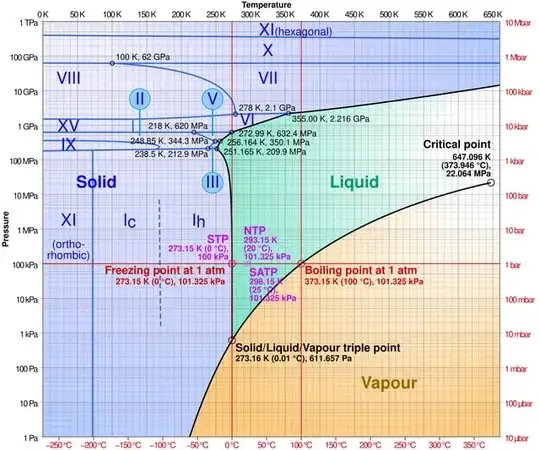I recently had seen an interesting experiment where a water bottle could be placed in a freezer for a while and would retain its liquid state until someone tapped on it, where it would quickly crystallize into ice. The explanations that I have seen for this experiment use terminology such as nucleation which I can't get an intuitive sense of. From what I learned from thermodynamics, when water is at zero degrees celsius, all energy taken from it goes into transformation before its temperature can decrease any further, as the molecules have to arrange themselves into a crystal lattice. I just need a very intuitive explanation of why transformation wouldn't always occur until a small amount of energy is applied through it with something like a tap on a water bottle.
3 Answers
For an (ice) crystal to form it needs to have a starting point to form around, that is called the Nucleation point. Liquids can be in a non stable state where they are supercooled but they can not make the transition to the lower state.
When you tap a water bottle you induce a small perturbation (disturbance) of the system and say move an air bubble to a more favorable spot so that nucleation can occur around it, or you move some impurity in a place so that ice starts to form around it. That is why the "tap" is needed, only to enable a nucleation site to come up.
Also from that Wiki page:
The most common crystallisation process on Earth is the formation of ice. Liquid water does not freeze at 0 °C unless there is ice already present; cooling significantly below 0 °C is required to nucleate ice and for the water to freeze. For example, small droplets of very pure water can remain liquid down to below -30 °C although ice is the stable state below 0 °C.
- 1,456
This is the difference between energetics, and kinetics.
For H2O at (say) at -10 °C, the ice phase has a lower energy than the water phase. However, if you have water, and you don't have a low energy route to get to ice, then the conversion does not happen. Liquid water is in a locally stable configuration. Any small changes in bonding or relative position results in an increase in energy, so there is an activation energy 'hill' over which the system has to climb to reconfigure as ice.
This is exactly the same as having a lump of carbohydrate, like sugar for instance, in an oxygen atmosphere. Conversion to CO2 and H2O would be energetically favourable, but there isn't a low energy route to get there. It needs heating to many hundreds of degrees to provide the activation energy to break the existing bonds to allow new ones to form.
Instead of supplying the necessary activation energy to overcome the energy barrier to reaction, both reactions may be made to go by lowering the barrier.
In the case of water to ice, that's by providing a substrate, a nucleation centre, on which water molecules can start to rearrange themselves into an ice configuration by making bonds with the substrate.
In the case of oxidation of carbohydrate, living cells lower the energy barrier to the reaction with enzymes, catalysts, substrates and reaction chains that allow it to happen at body temperature.
- 843
Besides the already given answer, and adding to your overall question, you might want to check out the concept of phase diagrams. These diagrams show you the phase of a particular substance under certain conditions of pressure and temperature. Water only freezes at zero degrees celsius in standard atmospheric pressure. At high pressures it starts to freeze at a slighter lower temperature, then it starts freezing at higher and higher temperatures. Eventually the pressure is so large that the molecules are effectively "squished", meaning you have ice even at really high temperatures. But at very low pressure the molecules essentially evaporate freely and you have a gas even at low temperatures.
Phase diagrams can be determined experimentally, but also through equations such as the Clausius-Clapeyron equation for the liquid and vapor phases (liquidus-vaporus).
- 4,386
